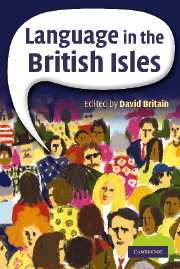Book contents
- Frontmatter
- Contents
- List of figures
- List of tables
- List of contributors
- Acknowledgements
- Map of the British Isles
- Introduction
- Part I English
- Part II The Celtic Languages
- Part III The Other Languages of the British Isles
- 15 Multilingualism
- 16 Caribbean creoles and Black English
- 17 Indic languages
- 18 Chinese
- 19 European immigrant languages
- 20 Sign languages
- 21 Channel Island French
- 22 Angloromani
- Part IV Applied Sociolinguistic Issues
- References
- Index
22 - Angloromani
Published online by Cambridge University Press: 16 January 2010
- Frontmatter
- Contents
- List of figures
- List of tables
- List of contributors
- Acknowledgements
- Map of the British Isles
- Introduction
- Part I English
- Part II The Celtic Languages
- Part III The Other Languages of the British Isles
- 15 Multilingualism
- 16 Caribbean creoles and Black English
- 17 Indic languages
- 18 Chinese
- 19 European immigrant languages
- 20 Sign languages
- 21 Channel Island French
- 22 Angloromani
- Part IV Applied Sociolinguistic Issues
- References
- Index
Summary
Introduction
In 1547 Andrew Borde published some sentences in a strange language, learned from people in a tavern who clearly had come from far away, under the heading ‘Egipt speche’. The sentences are still understandable today to the majority of Gypsies (from ‘Egyptians’) or Roma in the world. It is the oldest specimen of the Romani language that has been written down (Borde's text is reproduced in Hancock (1978) and Acton & Kenrick (1984:118)).
Romani is the language spoken by the people called ‘Gypsies’ by outsiders. Most speakers call themselves ‘Rom’, plural ‘Roma’, which means ‘human, man, husband’. The speakers call their language Romanes, an adverb meaning ‘in the manner of a Rom’, or Romani čhib, ‘Rom tongue’. In western Europe, all Gypsies use the term Romanes, but not all use the term ‘Roma’ for their group. In Britain two names have been documented. Kalo was used by the Gypsies in Wales, whose language became extinct in the twentieth century, and Romanichal is still being used in England.
The first Roma had arrived in south-eastern Europe around the year 1200. In the following centuries they spread over Europe. By the sixteenth century virtually all countries had a population of Roma, including Great Britain. Romani finds its origins in India. Linguistic evidence suggests that the ancestors of the Romani speakers must have left India around the year 1000. They travelled as one community through Asia to south-eastern Europe, from where they spread.
- Type
- Chapter
- Information
- Language in the British Isles , pp. 368 - 374Publisher: Cambridge University PressPrint publication year: 2007
- 2
- Cited by

